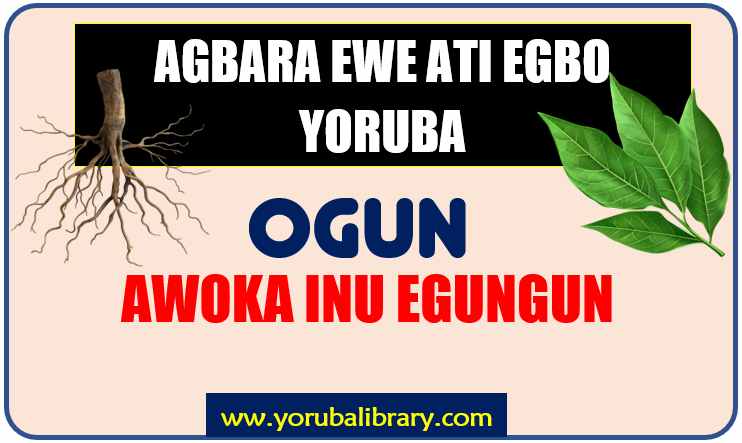
support@yorubalibrary.com
+2348073529208, 07038599574

Among the Yoruba, Awoka (arthritis and joint pains) was seen not only as a sickness of the bones but as a condition that disturbed the balance of body, and energy. When a person struggled with constant stiffness, swollen joints, or difficulty in walking, elders believed it reduced their ability to participate fully in family, farming, and community life. Our ancestors developed Ogun Awoka as a system of natural healing to ease joint pain, improve mobility, and strengthen the body’s inner energy. These remedies were not just about relieving physical discomfort — they were combined with dietary discipline, ensuring wholeness of the body and mind.
Our ancestors developed Ogun Awoka as a system of natural healing to ease joint pain, improve mobility, and strengthen the body’s inner energy. These remedies were not just about relieving physical discomfort — they were combined with dietary discipline, ensuring wholeness of the body and mind.
Arthritis in Yoruba tradition was understood as physical (caused by age, strain, or imbalance in the body), inherited weakness. Healing therefore required a combination of herbs, incantations, and lifestyle changes.
For centuries, Ogun Awoka served as a trusted method in communities where hospitals were not accessible. Even today, its principles remain part of heritage for those who wish to draw strength from Yoruba traditional healing.
Disclaimer
Yoruba Library and its Team will not be held liable for improper usage or any loss arising from improper use, wrong application, inability to find needed materials, or misinterpretation of this article. This article is provided strictly for guidance and educational purposes.
Symptoms Linked to Awòkà (Arthritis)
In Yoruba understanding, arthritis was recognized through several physical, and emotional signs:
• Persistent joint pain — Knees, wrists, and fingers often stiff and sore.
• Swelling — Joints appearing larger or inflamed.
• Difficulty in movement — Struggling to walk, bend, or lift.
• Weak grip — Loss of strength in holding objects.
• Restlessness during sleep due to pain.
• Sudden tiredness after minor activity.
• Reduced participation in communal life because of weakness.
How Our Forefathers Treated Awoka in the Past
Yoruba elders treated arthritis through remedies:
1) Herbal applications — Leaves and roots ground into pastes for rubbing swollen joints.
2) Steam therapy — Bathing or steaming with hot herbal water to relieve stiffness.
3) Healing drinks — Decoctions prepared to strengthen bones and improve blood flow.
4) Massage with oils — Using palm oil or herbal oil to soften stiffness.
Below are some of plants and roots which our forefathers previously used in treating Awoka:
(i) Ewe Atare
(ii) Ewe Efinrin
(iii) Eepo Obobo
(iv) Ewe Gbegi
(v) Ewe Jenjoko
(vi) Egbo Akoko
(vii) Ewe Ogede Odo
Have you heard of Yoruba Herb Dictionary? This contains names of Yoruba Leaf, Roots, Barks, Characteristics, Properties & Identification with HD Pictures. Order below or download sample here
A-Z HERBS & LEAF DICTIONARY #4KOne Yoruba proverb says "Bí olóde ò kú, òde rè kì í wu Gbégi". Do you know that Gbégi is actually a leaf/plant? Get Yoruba Proverbs on Plants and Herbs, which is a collection of Untold Wisdoms Hidden in Leaf and plants comprising their Life Applications & Moral Teachings. Order below or download sample here
YORUBA PROVERBS ON PLANTS #4KThe Healing Process in Traditional Practice
When preparing remedies for Ogun Awoka, Yoruba elders followed structured steps to ensure both physical relief and spiritual alignment:
• Collecting herbs, roots, or barks at specific times of the day believed to carry higher potency.
• Purifying and pounding materials into decoction, soak, or ointment form.
• Applying carefully through rubbing, drinking, or bathing depending on the case.
• Combining treatment with dietary and lifestyle restrictions to maximize healing.
Differences Between Yoruba and Modern Arthritis Treatment
While both Yoruba and modern systems seek to relieve arthritis pain, their approaches differ:
1) Focus of healing —
Yoruba remedies emphasize balance of body energy, circulation strength; modern medicine focuses on inflammation and pain reduction.
2) Materials used —
Yoruba healers relied on herbs, roots, and natural oils; modern medicine uses steroids, painkillers, and physiotherapy.
3) Approach to recurrence —
Yoruba healing often included lifestyle change; modern treatment emphasizes continuous medication or therapy.
Safety First: Important Contraindications and Considerations
• Pregnancy and Lactation —
Some herbs may be too strong for women if mistakenly consumed.
• Underlying Conditions —
People with kidney, liver, or heart problems must use remedies cautiously.
• Quality of Source —
Herbs from polluted or chemically treated areas are unsafe and must never be used.
Needed Materials (Leaves, Roots, Bark, etc.)
The medicinal approach for this requires careful selection of natural materials traditionally known to our elders. These are combined to ensure potency.
The instruction you will receive is the original account of our forefathers, preserved and tested over time. Many people have used them with testimonies of relief. Just ensure you follow the correct guidelines. Click Unlock Secret below
Application Process
The strength of Yoruba medicine depends on how materials are handled. Proper pounding, boiling, or steeping — done in the right way and at the right time — ensures the remedy remains potent. Click Unlock Secret below
Uses
The prepared remedy must be applied in the correct manner — whether for drinking, steaming, bathing, or chest rubbing — and taken in the right dosage for it to remain effective.
1) Some leaf required special utterances/chants before they can be effective. Where applicable, this will be stated in the PDF
2) The methods of getting the needed items like leaf, bark, roots by yourself is covered in the PDF
3) Saa bi Ologun ti wi, ki o le baa je... (Follow instructions for it to remain potent). You're getting a Real and Original account of our fore fathers.
With Numerous Satisfied Clients...